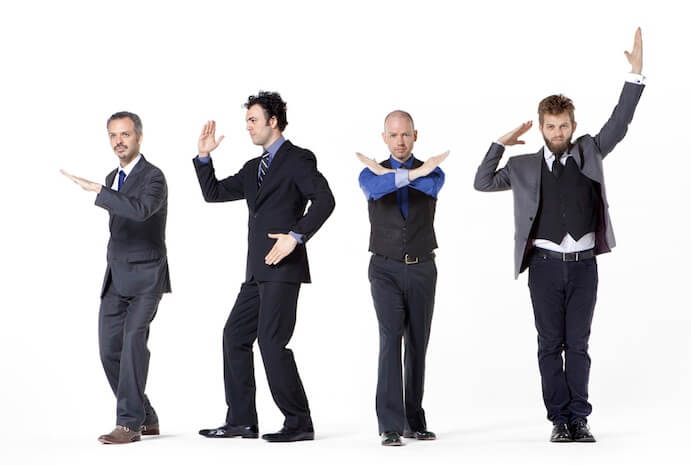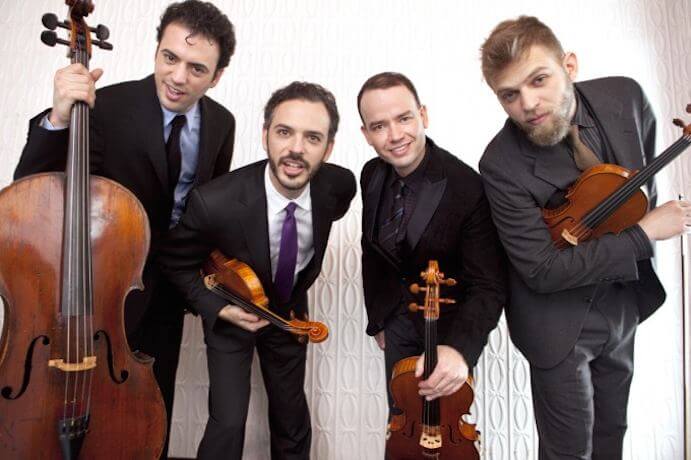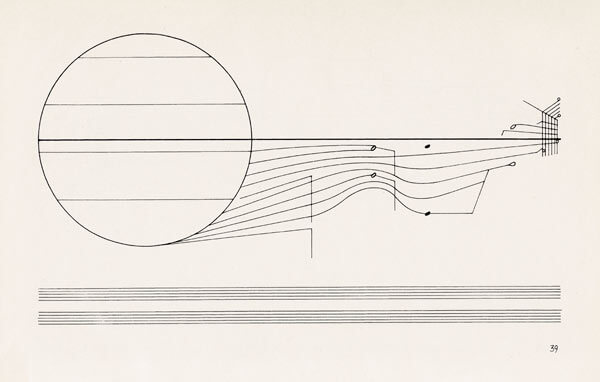Composition is such a solitary act. So much so that we can easily forget just how huge and diverse the new music community is becoming. Old camps have dissolved into the poly-stylistic hodgepodge that is our new music scene. It might be easy to lose sight of our times, but fortunately Brooklyn Rider‘s latest album is providing us with a nice road map of the territory through this new set of compositions for string quartet by non-classical composers.
One of the main goals of this album was to honor the present through emulating a multi-disciplinary spirit born out of the friendship between Russian artist Wassily Kandinsky and Arnold Schoenberg. The two were members of the artist collective Der Blaue Reiter (Our Very Namesake), who collaboratively published an anthology of art, music, and essays titled Der Blaue Almanach (The Blue Almanac) in 1912. The Brooklyn Rider Almanac is an anthology with similar aspirations, told through the medium of the string quartet with the poly-stylistic visions of a diverse collection of composers, each incorporating an element by a particular influence in their works.
Opening the Almanac is Rubin Kodheli’s Necessary Henry!. Henry has a cool, albeit sometimes incessant energy contrasted with some fun fragmented moments. A lot of these riffs could easily be imagined as distorted guitars backed with some rippling double-bass drums, almost to the point where it feels like this piece is an arrangement rather than written originally for string quartet. Eric Jacobsen, Brooklyn Rider’s cellist, does these riffs due diligence with a sustained and infectious rhythmic energy.

Brooklyn Rider
Dana Lyn’s Maintenance Music opens with tuning (“maintenance”) gestures accompanying a beautiful cello melody, which is in turn is answered by the viola and its own melting backdrop of glissandos. I was hoping this gorgeous exchange would return, but unfortunately this was not the case. Lines bounce back and forth between the violins in Padma Newsome’s Simpson’s Gap, building a lively web of sound as the ensemble acts like one singular instrument. A lovely folksy line eventually comes forward, matched by a fast and nervous counter melody which sounds like it’s begging to be let into the foreground. Like the previous track, this piece seems to be through-composed, and its material unfolds mostly without reference to what came before it.
Opening repetitions give way to more repetitions in Daniel Cords’ The Haring Escape, and while the piece has some nice figures, it sometimes gets a bit lost in its rapid internal dialogues. Despite this, there is some edge in the middle to the piece, if only approaching it a bit cautiously, and too briefly. Following this is a simple waltz-y tune that opens Aoife O’Donovan’s Show Me; perhaps mirroring the simplicity of Faulkner’s language in The Sound and The Fury, which the composer was reading while she was on a train ride in Germany. This simple language develops the opening tune elegantly. A second song-like cello tune matches this atmosphere and states its case solidly as the piece moves gently from one section to the next, never too out-going but always sweetly.
Vijay Iyer’s love for James Brown is present in nearly every section of Dig The Say. Brown’s grooves are given a maniacal homage, and their ferocity and energy is pretty much everywhere you turn your ear, even as the music grows quieter and quieter. A thick and heavy middle section contrasts the funk, but this somber mood doesn’t get the rest of the music down. Greg Saunier’s Quartet is quite different from the rest of the tracks on this album. Unlike the riffy-ness that permeates most of the pieces, this one seems focused more on jagged unisons, extreme voice-leading, silences, and odd phrasings. This isn’t necessarily a bad thing; in fact the stylistic contrast was a nice relief. Next was Ethan Iverson’s Morris Dance; a strange blend of quasi-romantic lyricism. The beginning gives way to a perky, almost sugary energy in its dancing moments. The dance gets briefly interrupted a couple times by a mournful line or lethargic rallentando, but immediately resumes undeterred. There’s a nice surprise towards the end that I won’t spoil.
The only piece with lyrics and clapping, Brooklyn Rider violinist Colin Jacobsen’s Exit, is a refreshing expansion of the string quartet. Shara Worden’s vocals colored and complimented the rest of the quartet quite wonderfully. The hand-clapping and strumming gave the quartet a light, bouncy, and fun pulse.

Brooklyn Rider– Photo by Sarah Small
Gonzalo Grau’s title comes from a Venezuelan saying, “don’t look for the cat’s fifth leg,” usually meaning someone is about to get in trouble. Five Legged Cat never gets into too much trouble, but feels like it might want to start some with its uneven col-legno rhythms and bodily percussions. Of course, it isn’t all aggression as there are some lovely lyrical moments interspersed throughout.
Christina Courtin’s Tralala is probably the most appropriate title for a piece on this album. An homage to the lighter side of Stravinksy at times, it dances ahead almost in a skip, stopping for a few moments in tender, solemn reflection. A pointed, rhythmically-driven counterpoint to the rest of the album, Glenn Kotche’s Ping Pong Fumble Thaw got my toes tapping several times. My one complaint would probably be the lack of variety in the musical figures, but it’s easily forgivable since pitch seemed secondary to the infectiously compounded grooves.
Bill Frisell’s John Steinbeck is a solid piece to end this album with. Its gentle, cascading lines and static sustained tones are expressive yet withdrawn; a hesitant character that’s content with gentle pushes towards motion. Steinbeck was also the shortest track on the album, but its gentle pace fills its brief duration well.
The Brooklyn Rider Almanac’s mission was a noble one; to honor the present. While there were some repetitive stylistic features surfacing more frequently than others, on the whole this collection of pieces paint a very exciting picture and had me hooked into the sounds many times throughout. In the end the Almanac is a friendly, albeit somewhat limited portrait of the cross-genre string quartet.





















